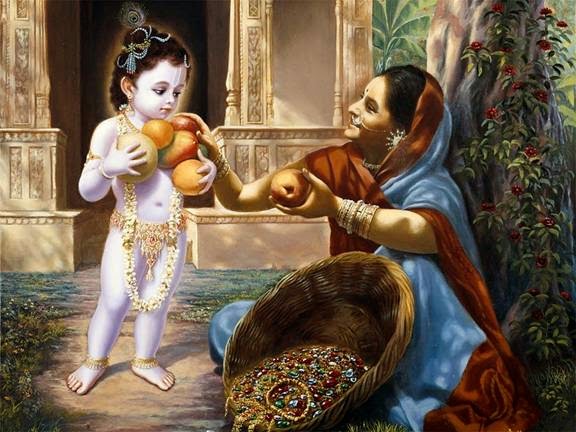According to Kapila Deva (Bhāgavatam 3.28-33). Start from the bottom and read upwards.
Grades of Being
Wherever The Mind Wanders
→ Japa Group
From Japa Reform Notebook
by Satsvarupa dasa Goswami
World acharya
→ KKSBlog
(Kadamba Kanana Swami, 23 December 2014, Cape Town, South Africa, Evening Lecture)
 It is interesting that Prabhupada was not a temple devotee! Prabhupada was that nice Mr De from the congregation. (Indian accent) He used to give nice donations for Janmastami. Also, he would play mrdanga. That was a nice thing.
It is interesting that Prabhupada was not a temple devotee! Prabhupada was that nice Mr De from the congregation. (Indian accent) He used to give nice donations for Janmastami. Also, he would play mrdanga. That was a nice thing.
This Mr De, he was a nice man, nice congregational member. Next moment, here comes the acharya! He did bigger than all the others. They could not believe it! Some really had a problem with it, “He always was a real business man. That is why he was so successful.” This was too much for them. How could Mr De, some congregational member who took sannyasa, but so much later than they took sannyasa, how could he become the next world acharya? Ah… was not even a temple devotee. So, let us see. Who will be the next? (laughing)
Bhagavatam-daily 102 – 11.08.18 – Don’t underestimate the danger of sonic temptation
→ The Spiritual Scientist
Bhagavatam-daily Podcast:
Latest photos from the construction of the Vedic Planetarium in…
→ Dandavats.com

Latest photos from the construction of the Vedic Planetarium in Mayapur, India (Album 30 photos)
See them here: http://goo.gl/vLFDWI
Kirtan at Klyde Warren Park- Dallas Texas (Album 24…
→ Dandavats.com

Kirtan at Klyde Warren Park- Dallas Texas (Album 24 photos)
Srila Prabhupada: As far as possible, therefore, the devotees in the Krishna consciousness movement gather to chant the holy name of Krishna in public so that both the chanters and the listeners may benefit. (Sri-Cantanya-Caritamrta, Antya-lila 1.101)
See them here: http://goo.gl/PUcU0v
Nityananda Trayodasi
→ New Vrindaban
 |
|
Join us on Feb. 1st, 2015 from 11am-3:30pm
|
 |
|
We would like to invite you and your family to celebrate Lord Nityananda's Appearance Day with us.
You will have the opportunity to:
|
 |
|
Festival Schedule
|
 |
|
11:30am: Bhajans
11:45am: Bathing Ceremony of Gaura Nitai
12:30pm: Offering of Bhoga
1:00pm: Arati & Kirtan
1:30pm: Class by His Holiness Varsana Swami
2:30pm: Nityananda Trayodasi Prasadam Feast
|
 |
|
The Significance of the Day
|
 |
|
Nityananda Prabhu appeared as Chaitanya Mahaprabhu's principal associate for spreading the congregational chanting of the holy names of the Lord.
"As Lord Nityananda is eternal, hence His lotus feet are also eternal and anyone who takes to the service of Lord Nityananda, (s)he also becomes eternal."- Srila Prabhupada
|
|
Service Opportunities
|
 |
|
$108: Nitai-Seva
|
|
|
includes:
|
|
|
We hope to see you here in New Vrindaban Dham.
|
|
Blue Mystic – A drama by Bhaktimarga Swami and Toronto Drama…
→ Dandavats.com

Blue Mystic - A drama by Bhaktimarga Swami and Toronto Drama Team (Album 20 photos)
Srila Prabhupada: Bhajananandi refers to one who is satisfied to cultivate devotional service for himself, and goshty-anandi is one who is not satisfied simply to become perfect himself but wants to see others also take advantage of the holy name of the Lord and advance in spiritual life.
(Sri-Cantanya-Caritamrta, Adi-lila, 7.92)
See them here: http://goo.gl/CIPTQp
Abhishek ceremony in Mayapur for Sri Advaita (Album 90…
→ Dandavats.com

Abhishek ceremony in Mayapur for Sri Advaita (Album 90 photos)
Srila Prabhupada: The Lord’s holy name is called sravana-mangala. This means that one receives everything auspicious simply by hearing the holy name.
(Srimad-Bhagavatam, 2.7.15 Purport)
See them here: http://goo.gl/VHzxmv
Sunday Program in Moscow (Album 5 photos)
Srila Prabhupada: The…
→ Dandavats.com

Sunday Program in Moscow (Album 5 photos)
Srila Prabhupada: The Hare Krishna movement is present in every millennium of Lord Brahma’s life, and the holy name is chanted in all the higher planetary systems, including Brahmaloka and Candraloka, not to speak of Gandharvaloka and Apsaroloka. The sankirtana movement that was started in this world five hundred years ago by Sri Caitanya Mahaprabhu is therefore not a new movement.
(Srimad-Bhagavatam, 2.7.15 Purport)
See them here: http://goo.gl/gL9Kkb
Appearance of Advaita Acharya
→ Mayapur.com
Please view the following galleries: Darshan Abhishek jaya jaya sri-caitanya jaya nityananda jayadvaita-candra jaya gaura-bhakta-vrnda Advaita acarya is an incarnation of Mahavisnu and thus non different (advaita) from the Lord. He is one of the principal associates of Sri Caitanya Mahaprabhu, the inaugurator of the yuga dharma Harinaam Sankirtana. His intense prayers to the Lord […]
The post Appearance of Advaita Acharya appeared first on Mayapur.com.
January 26th, 2015 – Advaita Acharya Darshan
→ Mayapur.com
The post January 26th, 2015 – Advaita Acharya Darshan appeared first on Mayapur.com.
Abhishek of Advaita Acharya
→ Mayapur.com
The post Abhishek of Advaita Acharya appeared first on Mayapur.com.
Devotees engaged in Harinama saving the souls drowning in the…
→ Dandavats.com

Devotees engaged in Harinama saving the souls drowning in the ocean of material existence :-)
Sunday Program in Moscow
→ SivaramaSwami.com
The post Sunday Program in Moscow appeared first on SivaramaSwami.com.
Celebrating Advaita Acarya’s appearance in Moscow: speakers Sivarama and Govinda Swamis
→ SivaramaSwami.com
(English/Russian)
The post Celebrating Advaita Acarya’s appearance in Moscow: speakers Sivarama and Govinda Swamis appeared first on SivaramaSwami.com.
Potato Puris (2 min video)
Ingredients: Wheat Flour (Gehu ka…
→ Dandavats.com

Potato Puris (2 min video)
Ingredients: Wheat Flour (Gehu ka atta)
Gram Flour (Besan)
Semolina (Rawa/Suji)
Roasted Sev
Beetroot
Potato (Aloo)
Green Chilli (Hara Mirch) and Ginger (Adrak) Paste
Cumin Seeds (Jeera)
Garam Masala
Cumin (Jeera) Powder
Chat Masala
Red Chilly (Lal Mirch) Powder
Salt (Namak)
Chopped Coriander (Dhaniya)
Oil (Tel)
Watch it here: http://goo.gl/P93uca
Preaching program in Kolhapur (Album 225 photos)
Members of…
→ Dandavats.com

Preaching program in Kolhapur (Album 225 photos)
Members of ISKCON Daiva Varnasrama Minstry attended a 7 days most wonderful festival known as Indian Cultural Festival at Kolhapur, Maharashtra.
See them here: http://goo.gl/M6M1MH
29 Jan 2015 – Disappearance Day of Sri Ramanujacharya
→ ISKCON Desire Tree
Bhakti Charu Swami on Srimad Bhagavatam 02.10.47
→ Gouranga TV - The Hare Krishna video collection
Bhakti Charu Swami on Srimad Bhagavatam 02.10.47
Our Biggest Yet
→ travelingmonk.com
By Popular Demand
→ travelingmonk.com
If smriti is compiled by sages, how can we know that it is free from the four defects?
→ The Spiritual Scientist
When Ajamila chanted with the wrong conception, why did Vishnutas come?
→ The Spiritual Scientist
From Pandurang Charan P
What is the result of chanting the names of godmen who have the name of God?
→ The Spiritual Scientist
From Pandurang Charan P
Answer Podcast:
Does upasana kanda contain things other than bhakti?
→ The Spiritual Scientist
Answer Podcast:
Download by "right-click and save content"
Are Gita and Bhagavatam meant for less intelligent people because they are parts of smriti?
→ The Spiritual Scientist
Answer Podcast:
Download by "right-click and save content"
When Vedas are said to be superior to pratyaksha and anumana, which meaning of Veda is used?
→ The Spiritual Scientist
Answer Podcast:
Download by "right-click and save content"
Gita 05.09 – Contact of senses & sense objects is not the problem – infatuation with the contact is
→ The Spiritual Scientist
Gita Verse-by-verse Study Podcast
Raganuga for Beginners?
→ The Enquirer
We’ve come to think of Rāgānugā Sādhana as an “advanced” practice. From what I can tell by considering what I have considered, it is more of a practice that evolves from a simple to a more advanced stage. There are advanced practitioners of Rāgānugā Sādhana and there are also beginners. Their qualifications and activities are the same in substance but different in quantity and depth of specificity and purity.
Dhyānacandra Goswāmī gave a very full, advanced version of Rāgānugā-sādhana in his Gaura-Govinda-Ārcana-Smaraṇa-Paddhati, which is practical only for those with very high qualifications: (for example) freedom from rajas and tamas and their impulses to karma, and thus the ability to meditate nearly 24 hours a day. Śrī Rūpa, however, gave a definition in Bhakti-rasāmṛta Sindhu which can scale easily to accommodate the initial as well as the advanced approaches to the path.
I’ll try to show how Śrī Rūpa’s definitions pertain to those just getting started with Rāgānugā-Sādhana.
His definition of how to practice starts with 1.2.294. He starts off by saying kṛṣṇaṁ smaran – “remember Krishna.” The word smaran is not esoteric. It is the essential principle of vaidhi-sādhana as well (smartavyaḥ satataṁ viṣṇuḥ, BRS 1.2.8).
Then he says janaṁ ca – “[remember Krishna] with his devotee.” That’s the hallmark of this (asya) type of sādhana, not found in vaidhi-sādhana. We always think of Krishna with his devotees.
Then he says preṣṭhaṁ nija-samihitam – This answers, “which devotee?” He says, “Think of Krishna with the devotee who loves Krishna in the way you yourself hope to love Krishna.”
This implies some adhikara. Specifically, its impossible to do rāgānugā unless we have some natural hope to love Krishna in a somewhat specific way. (laulyam/lobha). We don’t need to be freed from rajas-tamas and qualified for constant samādhi meditation to begin rāgānugā-sādhana. We just need a natural, clear, steady aspiration for a specific type of love of Krishna. That’s the actual bar, below which its not possible to even begin rāgānugā.
Next, Śrī Rūpa clarifies how to best “remember Krishna with his devotee” — tat-tat-kathā-rataś cāsau. “Remember them by always hearing about their love.”
Then he adds, kuryād vāsaṁ vraje sadā. “Always make your residence in Vraja.” On one hand this is a practical advice: if I want to always hear about the love of Krishna and a particular devotee, my best bet is to surround myself with others who have similar interests. So I should move to Vraja. On the other hand, it could mean “If you constantly hear about the love between Krishna and the devotee you admire, you will effectively always be living with them in Vraja.” The second interpretation seems better, since not every rāgānugā practitioner lives in Vṛndāvana. Even Mahāprabhu and his extremely elevated associates lived in Pūri.
Now, we come to 295. This one is about seva, “service.” We have to do 294 before we are capable of doing 295; we have to cultivate interest in and familiarity with Krishna’s relationship with the devotee we admire, before we can come to the instructions in 295, which advise us how to apply that information to our practical sevā.
The verse is about sevā – that is the topic. Sevā has two forms (the rūpa of the practitioner is not the topic, the rūpa of seva is the topic): a practical form (sādhaka-rūpeṇa) and an ideal, perfect form (siddha-rūpeṇa). In this rāgānugā path (atra) sevā must operate through both forms. We must execute the practical form of the seva but the more important (hi) aspect is to also (ca) be participating in the ideal, perfect form of the seva.
A very advanced practitioner could follow Dhyānacandra Goswāmīs system for elaborately envisioning the ideal form of seva, but it is not necessary. The new practitioner of Rāgānugā simply performs their external deeds (performing kīrtan, worshipping the deity, cleaning the temple, etc) while maintaining awareness of the internal significance of that deed, in the context of the relationship with Krishna that he or she aspires to.
Śrī Rūpa thankfully states this fairly explicitly by saying, tad-bhāva-lipsunā kāryā “[Participation in this internal form is done by] connecting it to the bhāva [mood of devotion] you are striving to achieve.”
He ends with vraja-lokānusārataḥ — “This is how you follow the essence of the denizens of Vraja.”
Then we come to 296, which answers, “What type of sevā should I do?”
śravaṇot-kīrtanādīni vaidha-bhakty uditāni tu, yāny angāni ca tany atra vijñeyāni manīṣibhiḥ
He says, “The intelligent apply themselves to a realized practice of the sevās described in the section on Vaidhi-bhakti: hearing, chanting, and so on.”
Here the words intelligent (manīṣībhiḥ) and realized (vijñeyāni) refer to doing the external form of these practices (sādhaka-rūpa) with awareness and focus on the internal relevance of them to ones cherished devotional ideal.
So, taken together, the three verses [BRS 1.2.294-296] read like this:
“Remember Krishna with the devotee who loves him in the way you yourself hope to love him, by always hearing about their love and residing in Vraja. Cultivate their same mood of love by doing your devotional practices with focus on their analogue relevance to the services you hope to perform. Thus intelligently apply yourself to all the practices of devotion described in the section vaidhi-sādhana, especially hearing and kīrtan.”
To do this sādhana doesn’t require freedom from lower modes, etc. But it does require that one have a natural and clear interest in a particular type of relationship with Krishna. It doesn’t require 24 hour meditation, or any elaborate system, although advanced practitioners can avail themselves of such systems. It simply requires that one hear about Krishna’s relationship with his beloved devotee, and try to emulate the spirit of that love when performing ones normal devotional practices.
Tagged: Raganuga, Raganuga Bhakti
Gita 05.08 – Don’t take credit for actions done by bodily mechanisms
→ The Spiritual Scientist
Gita Verse-by-verse Study Podcast
Still seeking justice after brother’s ’79 killing
→ ISKCON News
Advaita Acharya – Part two
→ KKSBlog
(Kadamba Kanana Swami, 29 November 2008, Lecture at Mamgachi)
namo brahmanya-devaya, go brahmana-hitaya ca, jagad-dhitaya krishnaya, govindaya namo namah
As Advaita Acharya continued his worship, he chanted this verse. Advaita Acharya fell prostrate before the Lord, seeking shelter at His lotus feet. Lord Gauranga lifted His lotus feet and placed it on Advaita Acharya’s head. Upon seeing this, the devotees became mad with jubilation, completely forgetting themselves. Some rolled on the ground; others embraced one another or slapped each other boisterously while many others cried out loudly. Advaita Acharya felt as if all of his desires had been fulfilled because the Lord had placed His lotus feet upon his head. Lord Caitanya then instructed, “Let Me see you dance!”
Advaita Acharya was not a young man. It said that when Sri Caitanya Mahaprabhu appeared in this world that Advaita Acharya was already fifty-two years old! So after the Lord revealed Himself which was in His twenty-second year, that means Advaita Acharya was seventy-four years old, and he was supposed to dance! Advaita Acharya lived another twenty-five years after the disappearance of Lord Caitanya and thus we understand that Advaita Acharya actually became a hundred and twenty-five years old.
Advaita Acharya happily began to dance and so the devotees started a very sweet melodious kirtan. As he continued dancing in front of the Lord, Advaita Acharya sometimes moved in a spirited manner and sometimes moved very gracefully. Sometimes, he felt very humbled and kept a bunch of straw in between his teeth. Sometimes, Advaita Acharya would spin around, jump into the air, then fall to the ground and roll back and forth. At other times, he would breathe deeply and quickly, and then fall unconscious.
We know that keeping a bunch of straw between the teeth indicates humility. It is in a mood of humility that one keeps straw between the teeth. Exactly why this custom is there, I cannot say, but it is there. And more important than the custom, is the mood that Advaita Acharya manifested because no one can do anything without the mercy of the Supreme Lord.
Although Advaita Acharya himself was also the Supreme Lord, still he was not govindam adi purusam – the original purusa, the original Supreme Personality of Godhead, Sri Krsna, but rather, he was the avatar of Lord Sri Krsna.
In the Bhagavad-gita (4.8) it is stated, paritranaya sadhunam, vinasaya ca duskrtam, dharma-samsthapanarthaya, sambhavami yuge yuge, that the Lord appears in various millenniums for the sake of establishing the principles of religion and to annihilate the miscreants. That is the work of the incarnations of the Lord. Only the Supreme Lord can give krsna-prema and that is why Advaita Acharya was very eager for Krsna to appear, because Advaita Acharya was not interested just to establish the principles of dharma; Advaita Acharya wanted to drown the entire world in love of God.
Now we can see how it is happening! We can see how gradually, little-by-little, invisibly, the sankirtan movement of Lord Caitanya is infiltrating. Because, as a person becomes touched by this sankirtan movement, as one hears the holy name or as one engages in devotional service, one becomes captured.
The Lord Needs Something
→ Japa Group
By making this effort to be attentive and concentrated, our relationship with the Lord is reciprocal and He blesses us with spiritual energy and eventually love for Krsna.
Friday, January 23rd, 2015
→ The Walking Monk
Excerpt About a Place and a Monk
An excerpt from Satsvarup Goswami’s book, “Srila Prabhupada-Lilamrita” read this morning in the front of the assembly of yogis, spiritual leaders from across the US and Canada. I was impressed by the contents, composition, set in ’58, India and to do with our guru, Srila Prabhupada.
“Alone and poor, Abhay (Prabhupada) returned to Vrindavan. He was sixty-two, but he wasn’t thinking of retiring. More than ever his mood was reflective and renounced. Because few people know him and because he wanted to unite, he kept to himself.
He enjoyed deep peace as a resident of Vrindavan. Outside his window, the sacred Yamuna flowed by in a peaceful panorama for his private audience. The Kesi-ghata neighbourhood was quiet, though in the predawn he could hear a few devotees bathing and chanting. When the moon was full the river seemed like a coolly resplendent jewel. And in the morning the sun would appear, like a red smudge, a fire burning through an opaque wall at last bursting forth and clearing the entire sky, until in the hot blaze of noon, while the room would be in shadows, Abhay could see from his window a shimmering sun high in the sky and glittering across the silver sheet of the gentle river. Without so much as leaving his room, from his doorway he could see hundreds of temples clustered together for miles in the friendly town of Vrindavan. The various punctual kirtans and bell ringings in the temples, the spontaneous songs of Lord Krishna in numerous homes and in the streets rose and filled the air with devotion.”
I love the writing about this monk who poised himself before taking a journey to western soil.
May the Source be with you!
6 KM
Bhagavatam-daily 101 – 11.08.17 – Let the ear lead to truth, not to illusion
→ The Spiritual Scientist
Bhagavatam-daily Podcast:
Download by "right-click and save content"
Sadly Missing Krishna
Balabhadra went to check this morning on…
→ Dandavats.com

Sadly Missing Krishna
Balabhadra went to check this morning on Krishna and found him in the same position. He sprinkled Govardhana dust and Radha Kund water on his head, put Tulasi leaves in his mouth and put a Lord Nrsringhadev kavitra on his horns. The sound of Hare Krsna bhajans could be heard in the barn from a CD player which we have playing 24/7. An hour later Balabhadra called me from the barn to tell me Krishna had passed away. He will be buried on the farm today.
Read the entire article here: http://goo.gl/o2cdqk
The Miracle Food
→ NY Times & Bhagavad Gita Sanga/ Sankirtana Das
HG Malati Mataji / CC Madhya 7.130
→ Kalachandji's Audio Archive
Can you give an example of unnecessarily provocative presentation of apara-vidya that we should avoid?
→ The Spiritual Scientist
Answer Podcast:
Download by "right-click and save content"









